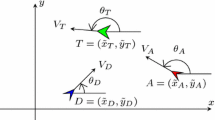Abstract
In this article, an aerial dogfight in three dimensions between two aircraft was modeled, with each aircraft having combined qualitative objectives of capture with avoidance. A spherical polar-coordinate system was devised to describe the system. From a standard point-mass model of aircraft dynamics for three-dimensional flight, a kinematic model was derived, with its corresponding controls for each aircraft. This kinematic model was then used, assuming bang-bang control functions for each aircraft, in order to determine a map of the game. A technique of trajectory dissection was introduced, whereby the airplane loci were decomposed in terms of regions of zero-level and saturation-level control values, and controllable and winning regions were determined for each aircraft using a Liapunov-function approach, the winning regions being calculated using the Getz-Leitmann theorem. A map of the game was constructed, and the barrier was found to be nonvoid. The concept of the posthumous mutual-kill strategy was introduced.
Similar content being viewed by others
References
M.D. Ardema, M. Heymann, and N. Rajan, “Combat games,”JOTA, vol. 46, no. 4, pp. 391–398, 1985.
M. Heymann, M.D. Ardema, and N. Rajan, “A formulation and analysis of combat games,” NASA TP2487, vol. 54, no. 1, June 1985.
A.E. Bryson, M.N. Desai, and W.C. Hoffman, “Eneregy-state approximation in performance optimization of supersonic aircraft,”J. aircraft, vol. 6, no. 6, pp. 481–488, 1969.
W.Y. Peng, and T.L. Vincent, “Some aspects of aerial combat,”AIAA J., vol. 13, no. 1, pp. 7–11, 1975.
C. Hillberg, and B. Järmark, “Pursuit-evasion between two realistic aircraft,”J. Guidance, vol. 7, no. 6, pp. 690–694, 1984.
H.J. Kelley, and L. Lefton, “Supersonic aircraft energy turns,”Automatica, vol. 8, pp. 575–580, 1972.
H.J. Kelley, and L. Lefton, “Differential turns,”AIAA J., vol. 11, no. 6, pp. 858–861, 1973.
H.J. Kelley, “A threat-reciprocity concept for pursuit-evasion,” IFAC Differential Games Conference, June 7–10, 1976.
A.W. Mertz, “To pursue or to evade—that is the question,”J. Guidance, vol. 8, no. 2, pp. 161–166, 1985.
N. Rajan, and M.D. Ardema, “Interception in three dimensions: an energy formulation,J. Guidance, vol. 8, no. 1, pp. 23–30, 1985.
J.V. Breakwell, “Pursuit of a faster evader,” Int. Conf. Differential Games, Warwick, 1974, pp. 243–256.
J.M. Skowronski, “Winning controllers for nonlinear air combat game with reduced dynamics,” Proc, AIAA Guidance, Navigation and Control Conference, Minneapolis, 1988, pp. 866–873.
M. Falco, and H.J. Kelley, “Aircraft symmetric flight optimization,”Control Dymnamic Syst., vol. 10, pp. 89–129, 1973.
J. Shinar, A. Merari, D. Blank, and E.M. Medinah, “Analysis of aerial turning maneuvers in the vertical plane,”J. Guidance Control, vol. 3, no. 1, pp. 69–77, 1980.
J.M. Skowronski, and R.J. Stonier, “The barrier in a pursuit-evasion game with two targets,”Comput. Math. Applic., vol. 13, no. 1-3, pp. 37–45, 1987.
W.M. Getz, and G. Leitmann, “Qualitative differential games with two targets,”J. Math. Anal. Applic., vol. 68, pp. 421–430, 1979.
J.M. Skowronski, and R.J. Stonier, “A map of a two person qualitative differential game,” Proc. AIAA Guidance, Navigation and Control Conference, Monterey, 1987, pp. 56–64.
M.D. Ardema, M. Heymann, and N. Rajan, “Analysis of a combat problem: the turret game,”JOTA, vol. 54, no. 1, pp. 23–42, 1987.
C.R. Hargraves, and S.W. Paris, “Direct trajectory optimization using non-linear programming and collocation,”J. Guidance, vol. 10, no. 4, pp. 338–342, 1987.
H. Ikawa, “A unified three-dimensional trajectory simulation methodology,”J. Guidance, vol. 9, no. 6, pp. 650–656, 1986.
R. Isaacs,Differential Games. Wiley: New York, 1965.
J.M. Skowronski, and R.J. Stonier, “Two-person qualitative differential games with two objectives,”Comput. Math. Applic., vol. 18, no. 1-3, pp. 133–150, 1989.
B. Etkin,Dynamics of Flight-Stability and Control, Wiley: New York, 1982.
P.K.A. Menon, “Short range nonlinear feedback strategies for aircraft pursuit-evasion,”J. Guidance, Control, Dynamics, vol. 12, no. 1, pp. 27–32, 1989.
A. Davidovits, and J. Shinar, “Eccentric two-target model for qualitative air combat game analysis,”J. Guidance, vol. 8, no. 3, pp. 325–331, 1985.
P.K.A. Menon, and E.L. Duke, “Time-optimal aircraft pursuit-evasion with a weapon-envelope constraint,” Proc. the 1990 American Control Conference, San Diego, May 1990, pp. 2337–2342.
Author information
Authors and Affiliations
Additional information
Editor: M. Ardema
Rights and permissions
About this article
Cite this article
Greenwood, N. A differential game in three dimensions: The aerial dogfight scenario. Dynamics and Control 2, 161–200 (1992). https://doi.org/10.1007/BF02169496
Received:
Revised:
Issue Date:
DOI: https://doi.org/10.1007/BF02169496




